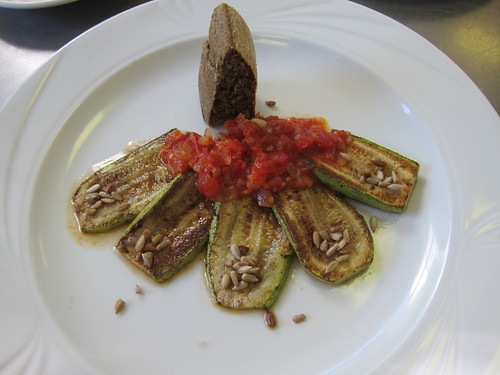Newsweek's Paul Wachter
writes about Apache-Navajo chef Nephi Craig and his mission to introduce traditional Native American cuisine to a broader audience. He writes:
"Nephi Craig graduated from culinary school in 2000 and began a promising career. In a few years, he was working his way up the stations at Mary Elaine’s, Arizona’s only five-star French restaurant, led by James Beard Award–winning chef Bradford Thompson. “I was getting a great French, classical training, but something was missing,” says Craig, who is 33. “The French tradition isn’t my tradition, and I wanted to cook in the tradition of my people: Apaches and Navajos.”
It’s an early Tuesday morning in late July, and Craig is driving his 10-year-old son, Ari, and me around the Fort Apache Indian Reservation, which is nestled in the White Mountains of eastern Arizona. Craig, whose mother is Apache and whose late father was Navajo, likes punk rock and skateboarding and is quick to laugh. Though he was born in Whiteriver (the reservation’s largest community) and spent most of his youth there—he also lived for several years on a Navajo reservation—he never thought he’d spend his adulthood here. He went to culinary school in Scottsdale and then spent three years cooking at an affluent country club in the northern part of the city before joining Mary Elaine’s.
“The French tradition isn’t my tradition,” he says, “and I wanted to cook in the tradition of my people: Apaches and Navajos. At Mary Elaine’s, we’d use a lot of local ingredients—rabbit, venison, squash, and corn—that I recognized as part of indigenous culinary history but were prepared in the French style,” he says. “And as I got better as a chef, I began to think about using my skills to showcase my own peoples’ culinary ways.”
But he had a lot of learning to do. “Even growing up on the reservation, I got the same two-page social-studies version of our indigenous history,” he says. “You know, the pilgrims and stuff.” After leaving Mary Elaine’s, he began to devote himself to rediscovering indigenous food. He traveled widely, hosting private dinners and conferences, and seeking out other Native American chefs as well as academics who had researched the cuisine of his ancestors. And when, in 2009, he learned of an opening at the White Mountain Apache Tribe’s Sunrise Park Resort, “it was,” he says, “the right time to bring my ideas back home.”
Craig was eventually appointed executive chef at the resort. His restaurant serves mostly standard American fare. But guests can also book seats at his chef’s table—and it’s there, as well as through a group he founded called the Native American Culinary Association, that Craig is acting on his dream: to restore and reinvent the largely forgotten cuisine of his forebearers.
A Search on the Zagat website for New York City lists 554 Italian restaurants, 191 French establishments, and 179 Japanese restaurants. There are 10 Ethiopian restaurants. But there isn’t a single Native American restaurant listed. There’s no culinary nod to the Lenape Indians who inhabited Manhattan long before Daniel Boulud and Mario Batali.
“American dining is based on our immigrant population, not our Native population,” says Lois Ellen Frank, a half–Kiowa Indian chef-scholar who wrote Foods of the Southwest Indian Nations. Ask an American today for his or her conception of Native American cuisine, and you’ll likely be met with some mumbling about Thanksgiving.
Before the Colonial era, Apaches relied for food on a “triptych of hunting, gathering, and raiding,” explained Thomas Mails in The People Called Apache. Mails was writing specifically about the Mescalero Apaches of New Mexico, Texas, and Mexico, but the same can be said of White Mountain Apaches. Acorns, seeds, and nuts were staple foods in their largely plant-based diet, which also included rabbits, birds, raccoons, fish, and other native animals. Food was local.
“If you lived in the Pacific Northwest, you would know the six types of salmon and know how to harvest them, but if you were a Navajo Indian on the Midwestern plains, you never would have seen one,” Frank says. Early European contact and trade introduced new foods, which many Native American chefs today also consider part of their peoples’ authentic culinary tradition. “It’s fair to talk about Navajo sheep even though sheep were imported to the Americas, just as we now consider the tomato to be an authentic and indispensable part of Italian cuisine even though it came from Mexico,” Frank says.
To read the rest of the article please click
here.

No comments:
Post a Comment